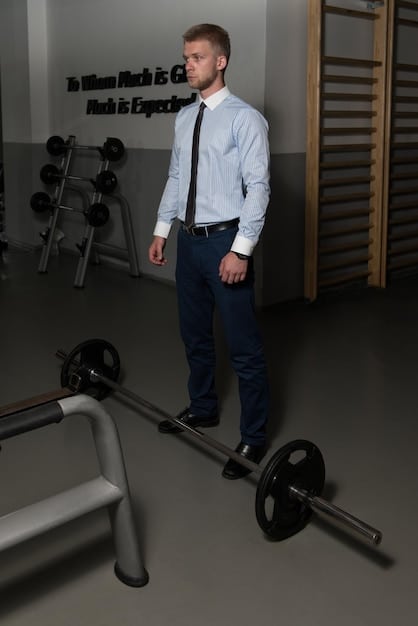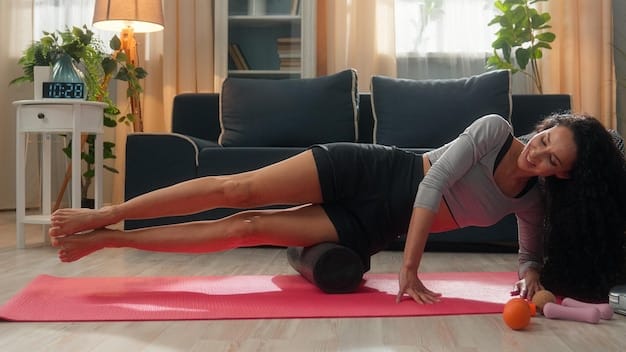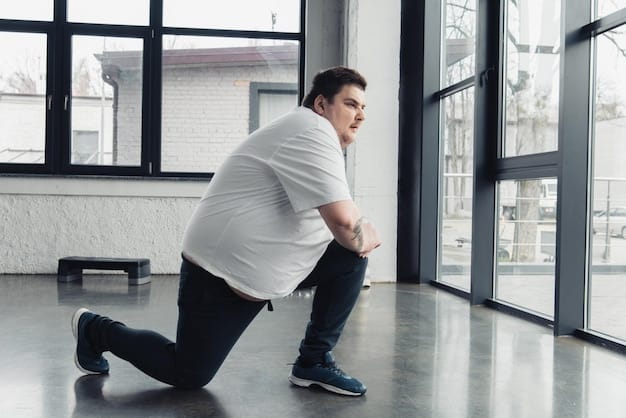Correct muscle imbalances: The core of symmetry

Correct muscle imbalances: The Corrective Exercise Routine for Symmetry focuses on identifying and addressing discrepancies in muscle strength and flexibility to achieve proper musculoskeletal alignment and enhanced physical performance, preventing injuries and promoting overall well-being.
In the intricate biomechanical symphony that is the human body, achieving optimal performance and preventing injury often hinges on a delicate balance. One might strive for impressive lifts or endurance feats, yet overlook the silent sabotage caused by an uneven foundation. This article delves into the critical pursuit of how to Correct Muscle Imbalances: The Corrective Exercise Routine for Symmetry, a nuanced approach that goes beyond mere aesthetics to unlock true physical potential and well-being. Understanding, identifying, and systematically correcting these imbalances isn’t just about looking good; it’s about moving efficiently, living pain-free, and building a resilient physique.
Understanding Muscle Imbalances: The Root of Asymmetry
Muscle imbalances are subtle yet significant discrepancies in the strength, length, or activation patterns of opposing muscle groups, or between the corresponding muscles on left and right sides of the body. These imbalances can stem from a multitude of factors, ranging from repetitive daily activities and poor posture to unilateral sports and even genetic predispositions. Such discrepancies often lead to faulty movement patterns, increased stress on joints, and a heightened risk of injury.
Consider, for instance, the common sedentary lifestyle where prolonged sitting shortens hip flexors and weakens glutes. This scenario creates an anterior pelvic tilt, leading to lower back pain and compromised hip mechanics. Athletes, too, are susceptible; a tennis player might develop a stronger dominant arm and shoulder, leading to rotational imbalances that affect spinal health and increase the risk of rotator cuff injuries. Identifying these foundational issues is the first, crucial step toward remediation.
Common Causes and Manifestations
Muscle imbalances are not random occurrences; they are often the predictable outcome of how we use, or misuse, our bodies. Prolonged sitting, for example, can lead to overactive, tight hip flexors and underactive, weak glutes and hamstrings. This creates a cascade of compensatory patterns throughout the kinetic chain. Similarly, repetitive movements in sports or occupational tasks can strengthen certain muscles while neglecting their antagonists.
The manifestations of these imbalances are varied and can impact daily life dramatically. They might appear as chronic pain in the lower back, neck, or shoulders, persistent tightness in hamstrings or hip flexors, or even asymmetrical development visible in the mirror. Furthermore, they can directly hinder athletic performance by limiting range of motion, reducing power output, and increasing susceptibility to common sports injuries like strained hamstrings, patellofemoral pain syndrome, or shoulder impingement.
- Sedentary Lifestyle: Prolonged sitting weakens glutes and core, tightening hip flexors.
- Repetitive Movements: Sports (tennis, golf) or work tasks create dominant-side strength, leading to asymmetry.
- Poor Posture: slouching forward rounds shoulders and tightens chest muscles, weakening upper back.
- Genetic Predisposition: Some individuals may naturally have slight anatomical differences contributing to imbalances.
Recognizing these underlying causes is vital for developing an effective strategy. Without addressing the root, any corrective exercises may only offer temporary relief. A holistic assessment, encompassing daily habits, training routines, and postural observation, forms the bedrock of a targeted intervention.
Identifying Your Specific Imbalances: A Self-Assessment Guide
Before embarking on any corrective exercise routine, accurately identifying your specific muscle imbalances is paramount. This isn’t about self-diagnosing medical conditions, but rather about becoming attuned to your body’s subtle cues and obvious asymmetries. Professional assessment by a physical therapist or a certified corrective exercise specialist is always recommended for a precise diagnosis and personalized plan. However, several self-assessment methods can offer valuable insights and guide your initial efforts.
Observing your posture in a mirror from different angles can reveal a lot. Do your shoulders round forward? Is one shoulder noticeably higher than the other? Does your pelvis tilt forward or backward excessively? Pay attention to how you stand, walk, and perform basic movements. Are your knees caving inward during a squat, or does one hip drop more than the other during lunges?
Key Movements and Observation Points
To identify imbalances, engage in simple functional movements and note any deviations or limitations. These observations provide a roadmap for prioritizing your corrective exercises. It’s often helpful to record yourself performing these movements on video to review your form objectively.
- Overhead Squat: Observe if your heels lift, knees cave in, or torso leans forward. This can indicate tight calves, weak glutes, or tight hip flexors/lats respectively.
- Single-Leg Balance: Note any wobbling, hip dropping, or compensatory leaning. This highlights deficiencies in ankle stability, glute medius strength, or core stability.
- Push-Up: Check for shoulder shrugging or excessive arching of the lower back. This could signal weak core, tight chest, or weak serratus anterior.
- Side Plank: Assess ability to maintain a straight line without sagging hips or rotation. Reveals core and oblique strength asymmetry.
Beyond visual checks, simply paying attention to how your body feels during and after movement can be insightful. Constant tightness in a particular muscle group, or a noticeable difference in strength or range of motion from one side to the other, are clear indicators. For instance, if one hamstring consistently feels tighter than the other after a run, it suggests an imbalance in flexibility or strength between the two.
The Principles of Corrective Exercise: Rebalancing the Body
Corrective exercise is not simply about doing more of what you already do. It’s a systematic approach designed to restore proper function and alignment by addressing underlying musculoskeletal imbalances. The principles governing this approach are rooted in understanding how the body compensates and how to reverse those patterns effectively. It often involves a combination of inhibiting overactive muscles, lengthening shortened ones, activating underactive muscles, and integrating new movement patterns.
The foundation rests on the concept of inhibition and lengthening. Overactive or tight muscles prevent their opposing counterparts from functioning properly. Releasing tension in these muscles through techniques like foam rolling or static stretching is crucial. Concurrently, activating and strengthening weak, underactive muscles helps to restore balance. Finally, integrating these newly acquired strengths and ranges of motion into functional movement patterns solidifies the corrections.
Inhibition, Lengthening, Activation, and Integration
This four-phase approach, often popularized by organizations like the National Academy of Sports Medicine (NASM), provides a clear framework for building a corrective exercise routine. Each phase serves a distinct purpose in the journey toward musculoskeletal balance and optimal movement.
- Inhibition (Release): Uses self-myofascial release (SMR) techniques like foam rolling to decrease activity in overactive muscles.
- Example: Foam rolling tight hip flexors or a tight thoracic spine.
- Lengthening (Stretch): Employs static stretching to increase the extensibility of overactive, shortened muscles.
- Example: Static stretches for hip flexors, hamstrings, or pectorals.
- Activation (Strengthen): Focuses on isolated strengthening exercises for underactive, weak muscles.
- Example: Glute bridges for weak glutes, or band walks for glute medius.
- Integration (Movement): Incorporates multi-joint, multi-planar movements to re-educate the nervous system and integrate corrected patterns into functional activities.
- Example: Squats with proper form, lunges, deadlifts, and planks.
It’s important to approach these principles with patience and consistency. Muscle imbalances develop over time, and correcting them is a gradual process. Rushing through exercises or neglecting any phase can hinder progress. The goal is not just to perform the movements, but to genuinely reconnect with your body and retrain its natural movement capabilities.

A Corrective Exercise Routine for Common Imbalances
While a personalized plan is always best, a general corrective exercise routine can address many common muscle imbalances resulting from modern lifestyles. This routine focuses on areas frequently affected, such as the hips, core, and upper back. It integrates the principles of inhibition, lengthening, activation, and integration, offering a balanced approach to restoring symmetry and function.
Perform this routine 3-4 times a week, ideally before your main workout or as a standalone session. Pay close attention to form; quality of movement far outweighs quantity. Always consult a healthcare professional before starting any new exercise program, especially if you have pre-existing conditions or pain.
Addressing Anterior Pelvic Tilt and Lower Cross Syndrome
Anterior pelvic tilt, often associated with Lower Cross Syndrome, is characterized by tight hip flexors and lower back muscles, coupled with weak glutes and abdominals. This common imbalance leads to an exaggerated lumbar curve and can cause chronic lower back pain. The aim of corrective exercises here is to inhibit the tight muscles and activate the weak ones.
- Inhibition & Lengthening:
- Foam Rolling Hip Flexors: Lie face down, place foam roller under one hip. Roll slowly from hip bone to upper thigh. Hold tender spots for 30-60 seconds. Repeat on other side.
- Kneeling Hip Flexor Stretch: Kneel on one knee, front foot flat. Gently push hips forward until stretch felt in front of hip. Hold 30 seconds, 2-3 sets per side.
- Foam Rolling Lumbar Spine (carefully): Lie on back, roller perpendicular to lower back. Gentle rolling only, avoid aggressive movement. Alternative: Child’s Pose (yoga).
- Activation & Integration:
- Glute Bridges: Lie on back, knees bent, feet flat. Lift hips off ground, squeezing glutes at top. Hold 2 seconds, 10-15 reps, 3 sets.
- Bird-Dog: On hands and knees, extend opposite arm and leg simultaneously, maintaining neutral spine. Hold 2 seconds, 10-12 reps per side, 3 sets.
- Plank: Hold forearm plank, maintaining straight line from head to heels. Engage core, avoid sagging hips. Hold 30-60 seconds, 3 sets.
Consistency with these exercises will gradually improve pelvic alignment, alleviate lower back stress, and enhance overall core stability. Focus on feeling the correct muscles working and avoiding compensation from stronger, overactive groups.
Correcting Upper Cross Syndrome and Shoulder Imbalances
Upper Cross Syndrome is marked by tight pectorals and upper traps, combined with weak deep neck flexors and mid/lower traps. This often results in rounded shoulders, forward head posture, and potentially shoulder pain or impingement. The corrective approach targets opening the chest and strengthening the supporting back muscles.
- Inhibition & Lengthening:
- Foam Rolling Thoracic Spine: Lie on back, foam roller under upper back. Hands behind head, gently roll up and down. Can add gentle extension.
- Pec Stretch in Doorway: Stand in doorway, forearms on frame. Lean forward gently until stretch felt in chest. Hold 30 seconds, 2-3 sets.
- Upper Trapezius Release (Manual): Gently press and hold tender spots in upper traps or use a trigger point ball against a wall.
- Activation & Integration:
- Rows (Band or Dumbbell): Pull band or dumbbell towards torso, squeezing shoulder blades together. Focus on controlled movement. 12-15 reps, 3 sets.
- Face Pulls (with band or cable): Pull band towards face, externally rotating shoulders. Excellent for posterior deltoids and rotator cuff. 12-15 reps, 3 sets.
- YTWLs (Prone): Lie face down, extend arms into Y, T, W, and L shapes, lifting slightly off floor. Focus on mid-back activation. 10-12 reps per shape, 2-3 sets.
These upper body corrections are fundamental for improving posture, reducing neck and shoulder tension, and creating a more balanced and functional upper torso. Regular practice will lead to greater shoulder stability and a more upright posture.
Integrating Corrective Exercises into Your Workout Routine
Simply performing corrective exercises in isolation is a good start, but the real magic happens when these new movement patterns are integrated into your broader workout routine. This means consciously applying the principles of good form, muscle activation, and balanced movement to your strength training, cardio, and daily activities. The goal isn’t just to “fix” an imbalance, but to hardwire the correct movement patterns into your neuromuscular system.
Think of corrective exercises as your warm-up or pre-habilitation. Performing them before your main lift can prime the right muscles, improve neural activation, and ensure you’re moving efficiently. For instance, doing glute activation exercises before squats or deadlifts can significantly improve hip drive and reduce lower back strain. During your workout, remain mindful of your form, focusing on controlled movements and feeling the target muscles working.
Pre-Workout Priming and During-Workout Awareness
Strategic placement of corrective exercises can enhance the effectiveness of your overall training. Using them as part of your warm-up dynamically prepares your body for the movements ahead, improving performance and reducing injury risk. During your workout, conscious awareness of muscle activation and technique reinforces the corrected patterns.
- Warm-Up Integration:
- Start with foam rolling and dynamic stretches that address your specific tight areas. For example, if you have tight hip flexors, do some lunges with a posterior pelvic tilt to stretch them.
- Follow with activation drills for your weak muscles. Glute activation before leg day, or serratus anterior activation before upper body pushes/pulls.
- Supersets/Circuit Training:
- Pair a strength exercise with a corrective exercise targeting an opposing muscle group. For instance, bench press immediately followed by face pulls.
- Or, if a muscle is underactive, perform an activation drill for it *between* sets of a compound exercise that relies on it. E.g., band walks between sets of squats.
- Mind-Muscle Connection:
- Throughout your main workout, consciously focus on engaging the previously identified “weak” muscles. When performing a squat, think about driving through your heels and squeezing your glutes at the top.
- Record yourself during exercises to review and refine your form, identifying any lingering compensatory patterns.
Consistency is key. It’s not about doing everything perfectly every time, but about making conscious efforts to integrate these principles whenever you move. Over time, these corrected patterns will become second nature, leading to more efficient, powerful, and pain-free movement, both inside and outside the gym.

The Long-Term Benefits of Symmetry and Balance
The journey to correct muscle imbalances is a continuous process, not a one-time fix. However, the dedication to achieving musculoskeletal symmetry and balance yields profound long-term benefits that extend far beyond aesthetics or immediate pain relief. These benefits encompass improved physical performance, significantly reduced injury risk, enhanced posture, and an overall elevated quality of life. It’s an investment in your body’s longevity and functional capacity.
When muscles work synergistically, the body moves with greater efficiency and less strain. This translates directly to better performance in sports, whether you’re a competitive athlete seeking an edge or simply looking to improve your recreational pursuits. Moreover, by removing the abnormal stresses that imbalances place on joints and soft tissues, the risk of common overuse injuries, sprains, and strains dramatically decreases. This proactive approach to health means spending less time recovering from setbacks and more time enjoying active living.
Injury Prevention, Enhanced Performance, and Quality of Life
The cumulative effect of a balanced muscular system is transformative. It’s about building a body that can withstand the demands of daily life and physical activity without breaking down. This resilience is a cornerstone of sustained physical well-being and active aging.
- Injury Prevention:
- Reduced Risk of Overuse Injuries: Common issues like runner’s knee, IT band syndrome, shoulder impingement, and lower back pain often stem from repetitive movements with underlying imbalances. Correcting these foundations minimizes joint stress.
- Improved Joint Stability: Balanced strength around a joint enhances its stability, reducing the likelihood of acute injuries like sprains and dislocations.
- Enhanced Performance:
- Increased Power and Efficiency: When all muscles work in harmony, power generation is optimized, and movements become more fluid and less energy-intensive. This translates to faster sprints, higher jumps, and stronger lifts.
- Greater Range of Motion: Correcting tight muscles restores optimal joint mobility, allowing for fuller, more effective movements in sport and exercise.
- Improved Quality of Life:
- Reduced Chronic Pain: Many postural and movement-related pains are alleviated when the body’s natural alignment is restored.
- Better Posture: Standing taller, moving with grace, and projecting confidence naturally follow when the muscular system is in balance.
- Increased Body Awareness: The process of identifying and correcting imbalances fosters a deeper connection to and understanding of one’s own body, leading to more intelligent movement choices overall.
Ultimately, a commitment to correcting and maintaining muscle balance is a commitment to living a more functional, pain-free, and active life. It empowers you to move with confidence and strength, maximizing your potential in every physical endeavor and safeguarding your body for years to come.
Beyond the Routine: Lifestyle Factors and Maintenance
While a dedicated corrective exercise routine is essential, its effectiveness is greatly amplified by addressing broader lifestyle factors. Muscle imbalances are often symptoms of unaddressed patterns in daily life, such as prolonged sitting, habitual postures, or even stress. Maintaining symmetry and balance long-term requires a holistic approach that extends beyond the gym and into every aspect of your day.
Consider your work setup: Is your workstation ergonomically optimized? Are you taking regular breaks to move and stretch? How do you carry your bag? Even seemingly minor habits like always crossing the same leg or sleeping in a particular position can contribute to imbalances over time. Becoming aware of these patterns and consciously making small adjustments can have a significant cumulative impact on your musculoskeletal health.
Ergonomics, Posture, and Active Recovery
Sustainable balance relies on consistent attention to how you treat your body outside of structured exercise. Proactive measures in daily life are just as important as the exercises themselves.
- Ergonomics for Daily Life:
- Workstation Setup: Ensure your computer screen is at eye level, keyboard and mouse are comfortably accessible, and chair supports your lower back. Optimize your desk height.
- Phone Usage: Avoid prolonged “text neck” by holding your phone higher or using a stand.
- Driving Posture: Adjust car seat for proper back support and ensure comfortable arm reach to the steering wheel.
- Mindful Posture and Movement:
- Breaks and Movement: Stand up, stretch, and move around every 30-60 minutes, especially if your job involves prolonged sitting or standing.
- Conscious Posture: Regularly check your posture throughout the day – are your shoulders rounded? Is your head forward? Engage your core and stand tall.
- Daily Habits: Alternate sides when carrying heavy bags, avoid always resting on one leg, consciously engage your glutes when climbing stairs.
- Active Recovery and Self-Care:
- Stretching and Mobility Routines: Incorporate daily gentle stretching, yoga, or Pilates to maintain flexibility and range of motion.
- Foam Rolling/Massage: Continue regular self-myofascial release sessions to prevent muscles from becoming overly tight.
- Hydration and Nutrition: Support muscle health and recovery through adequate water intake and a balanced diet rich in protein and micronutrients.
The journey to correcting muscle imbalances is a testament to the body’s incredible adaptability. By consistently nurturing its balance through targeted exercises, mindful living, and proactive self-care, you equip yourself with a resilient, functional, and pain-free physique for years to come.
| Key Point | Brief Description |
|---|---|
| 🔍 Identify Imbalances | Observe posture and movement patterns; consider professional assessment for precise diagnosis. |
| ⚙️ Corrective Exercise Principles | Follow Inhibition, Lengthening, Activation, and Integration (ILAI) phases for effectiveness. |
| 🤸 Routine Application | Integrate specific exercises for common issues like pelvic tilt and rounded shoulders into your regimen. |
| 🌟 Long-Term Benefits | Anticipate improved performance, reduced injury risk, and enhanced overall quality of life. |
Frequently Asked Questions About Correcting Muscle Imbalances
▼
Muscle imbalances stem from various factors including repetitive movements, poor posture, prolonged sitting, unilateral sports training, and even genetic predispositions. These lead to some muscles becoming overactive and tight, while their opposing counterparts become weak and underactive, disrupting the body’s natural alignment and function.
▼
Self-assessment can involve observing your posture in a mirror (e.g., rounded shoulders, hip tilt) and performing functional movements like overhead squats or single-leg balance tests. Look for compensatory movements or asymmetries. For precise diagnosis, consulting with a physical therapist or certified corrective exercise specialist is highly recommended.
▼
ILAI stands for Inhibition, Lengthening, Activation, and Integration. Inhibition uses techniques like foam rolling to release tight muscles. Lengthening involves static stretching. Activation focuses on strengthening weak muscles. Integration means incorporating these corrected patterns into functional movements and daily activities for long-term retention.
▼
Yes, many forms of chronic musculoskeletal pain, especially in the neck, shoulders, and lower back, are directly related to muscle imbalances and poor posture. By restoring proper alignment and muscle function through corrective exercises, the abnormal stresses on joints and tissues are reduced, often leading to significant pain relief.
▼
For best results, aim to incorporate corrective exercises 3-4 times a week. They can be performed as a dedicated session or integrated into your warm-up before regular workouts. Consistency is key, as re-educating the nervous system and reshaping muscle patterns takes time and repeated effort to become permanent.
Conclusion and the Path to Lasting Symmetry
Addressing muscle imbalances is a journey toward profound physical resilience and improved quality of life. It’s an ongoing dialogue with your body, learning to listen to its signals and respond with targeted, intelligent movement. By scientifically applying the principles of inhibition, lengthening, activation, and integration, individuals can systematically restore their body’s inherent symmetry, moving beyond mere aesthetics to unlock true functional strength and freedom from pain. This dedicated approach not only enhances athletic performance and reduces the risk of injury but deeply enriches daily existence, allowing for a more confident, capable, and vibrant interaction with the world. Embrace this comprehensive strategy, and your body will thank you with lasting balance and enduring vitality.





